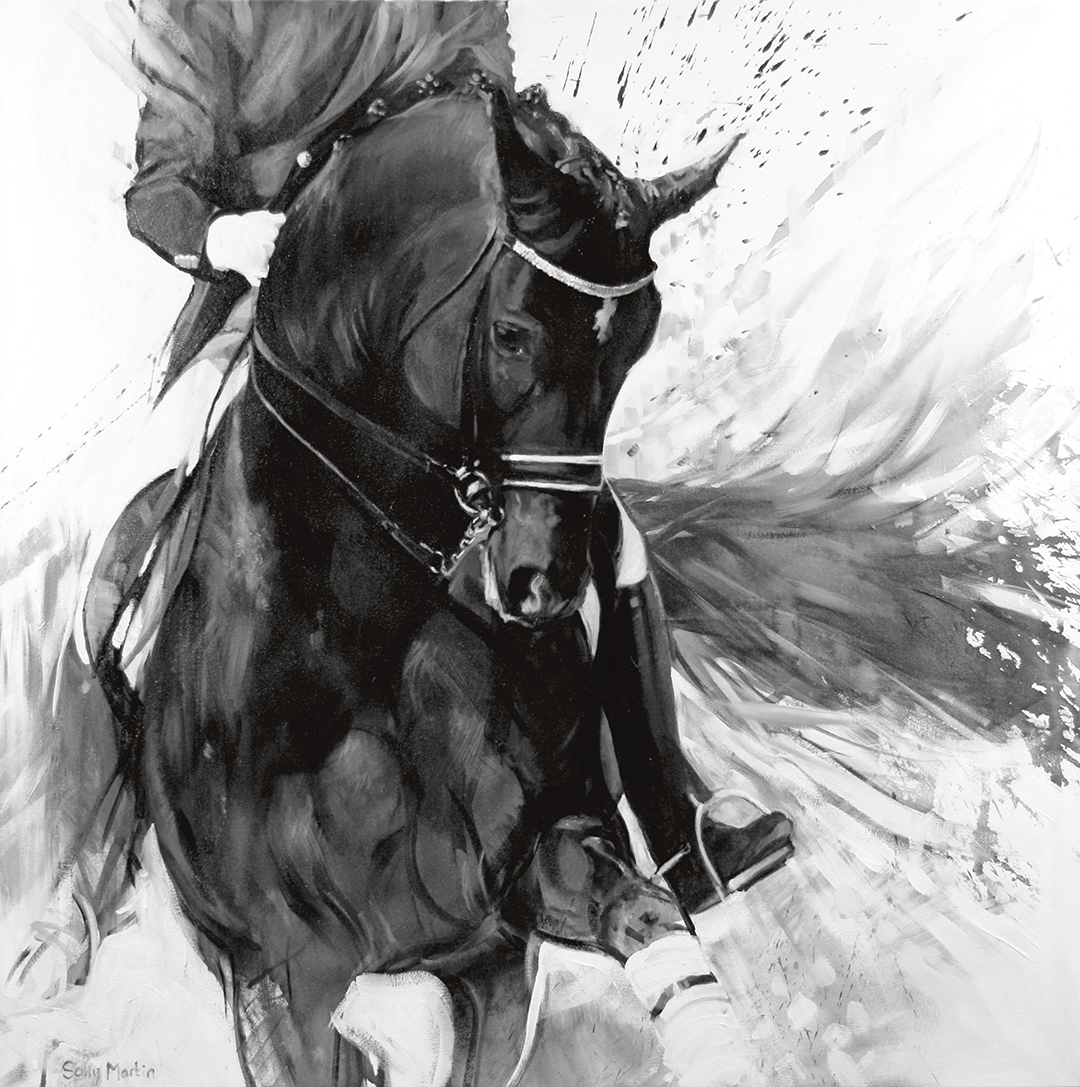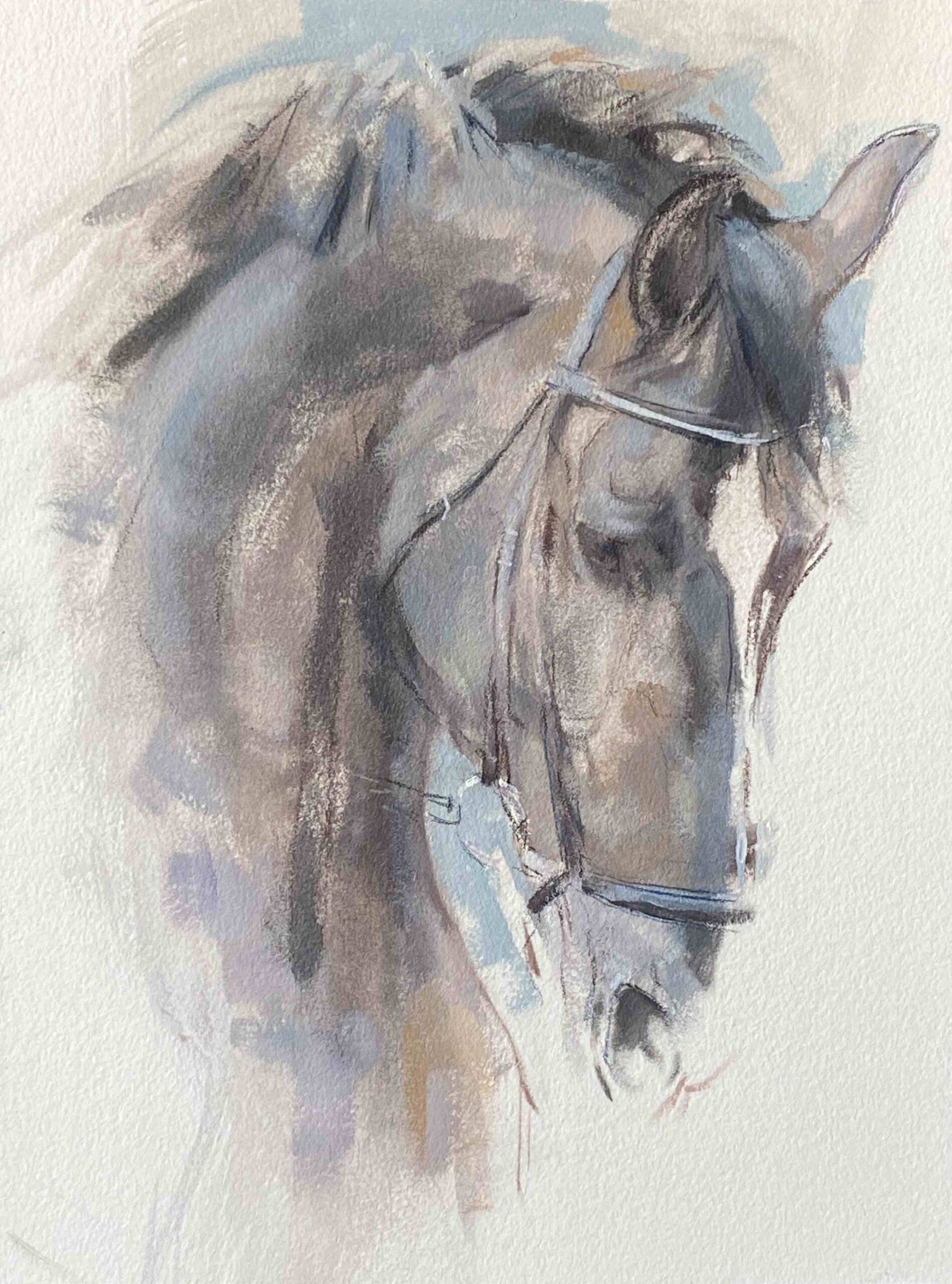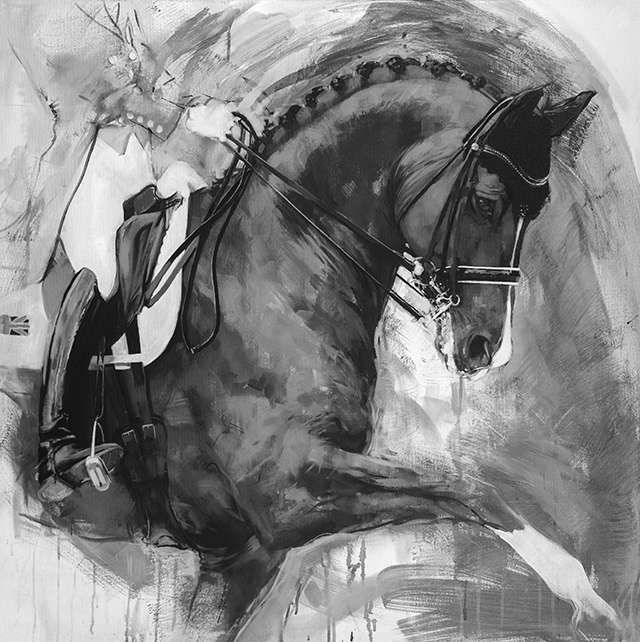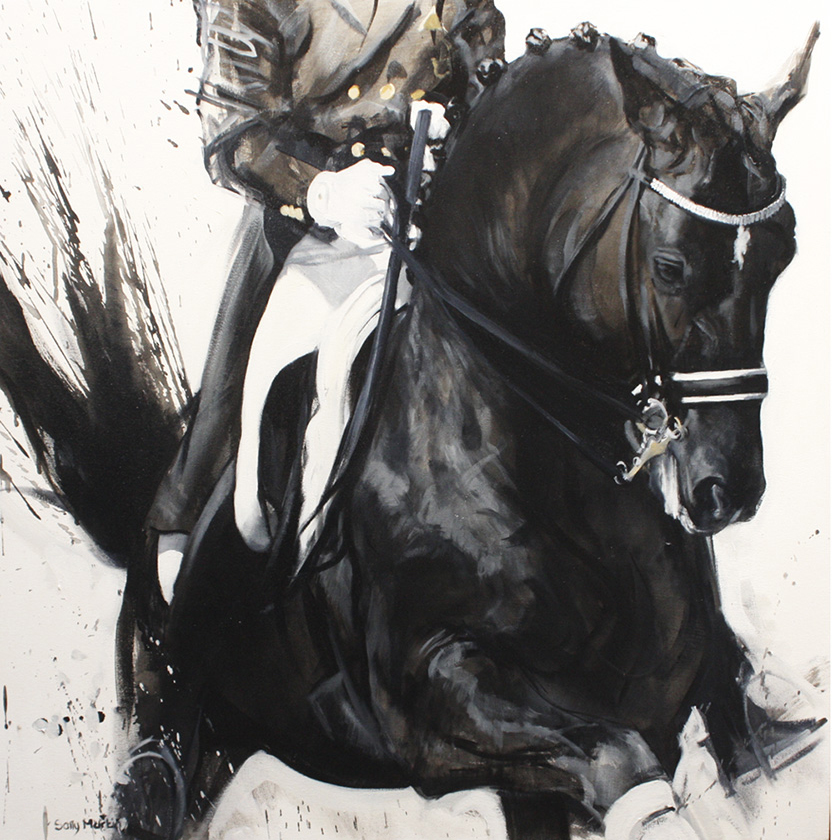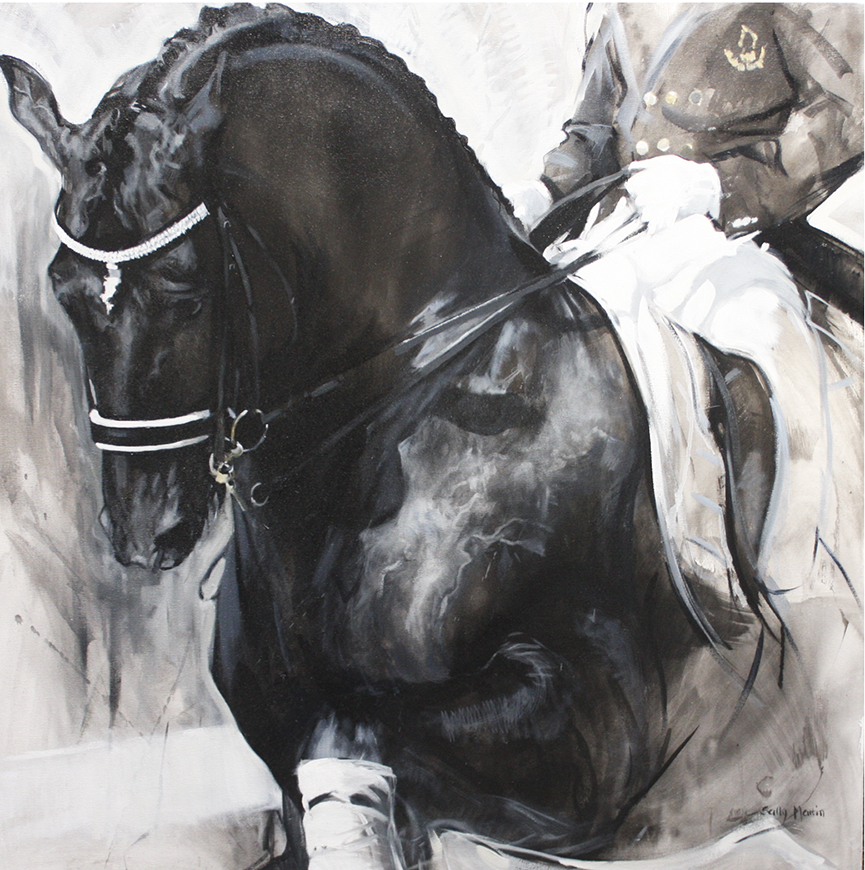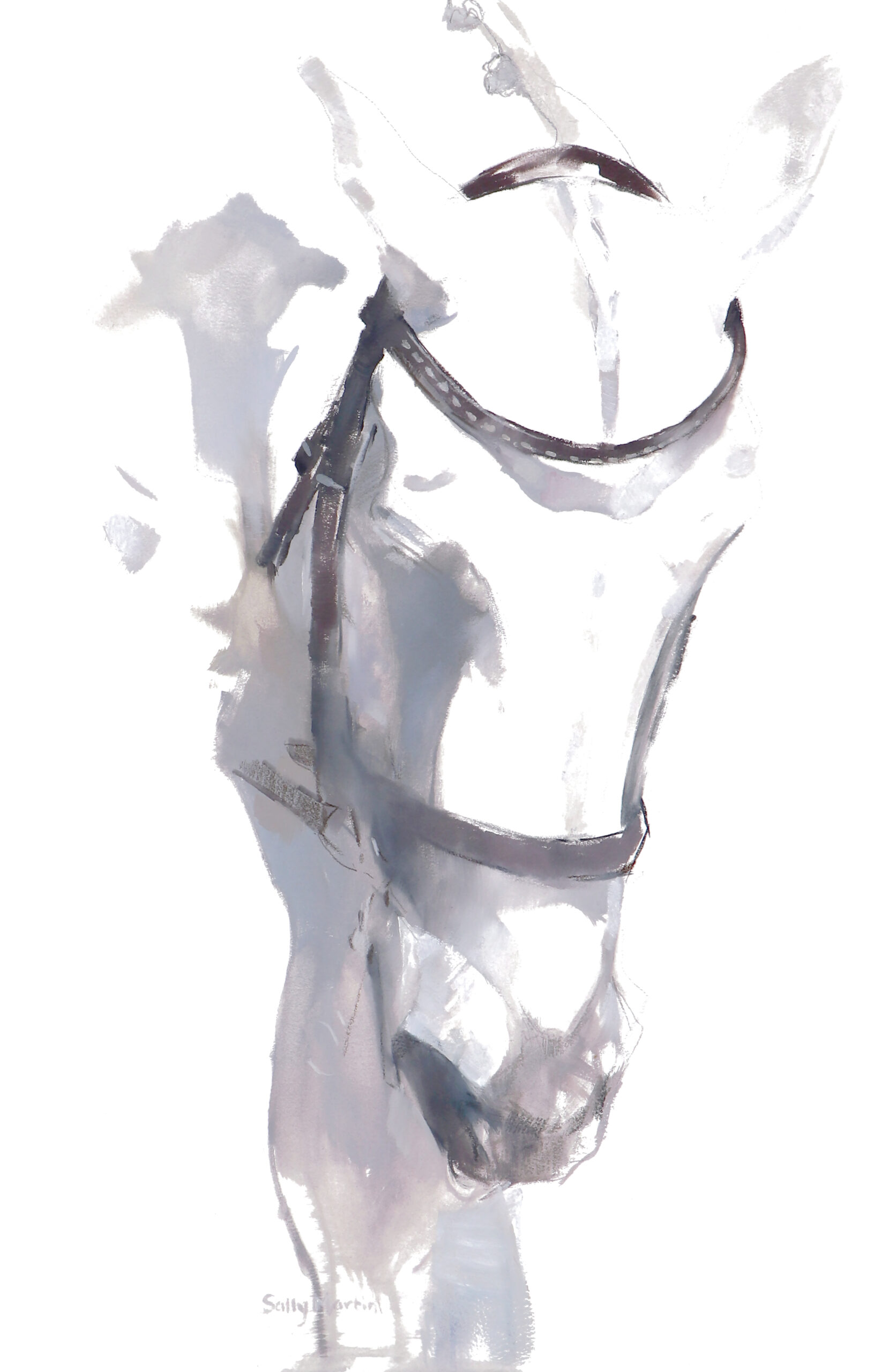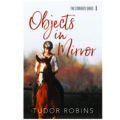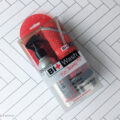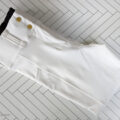Occasionally (as an artist myself) I come across an artist that really jives with me. For me, Sally Martin is one of the rare few I feel strong kinship with in terms of how we approach an image. Some of her works (the black and white ones), feel very similar to some explorations I made when I was in my 20s (though they were not of horses). I can feel the work in a way I can’t when I look at something more realistic and strict to nature (even if I admire those artists significantly). I can look at a painting or sketch of Sally’s and know what it feels like to make those strokes and adjustments in a way I usually can’t…so her work is extremely appealing to me. I hope that you find her work as beautiful, inspiring and energizing as I do. Sally also happens to be an interesting woman with an interesting story…so that’s all the better. Enjoy!
How did you become an artist? What is your story?
From as early as I can remember, I was absolutely besotted with anything horse or pony related. I just thought, at that young age, it was magical that horses and ponies would actually allow humans to sit on their backs. As I grew up and immersed myself in the world of children’s pony books I loved the idea of a partnership with a pony. Having quite a problematic childhood and at times feeling isolated, confused and lonely, the idea of having a pony friend who would be on my side, a way of being born away from challenging situations, and the pure beauty of the horse were reasons for the connection.
My family was working class. We didn’t have much money and lived in social housing in town. I didn’t have access to the countryside or horses and ponies, but I did have access to a pony magazine that was published at the time and in it every year they ran an art competition to win a pony. I think just the fact of being able to create my own pony world through my drawings was a way I could feel closer to the world of ponies, riding and all of the things that I was reading about in my children’s pony books. I could create that world with with my pencil and at that early age both things became fused together as naturally as anything. Although eventually I did get access to ponies and riding in my mid teens, I just connected with the world of the horse through my art. That connection has stayed true over the years.
The two threads of horses and art have woven themselves through my whole life since then. I got accepted into art school. I remember it being quite a big shock that the thing that I wanted to learn (which was the techniques and processes of painting) at that time wasn’t available through the British Art School foundation course mode. They were much more interested in conceptual art, so they weren’t actually offering the things that I wanted to learn. As a result I only spent a few a few months at art school before leaving to eventually pursue a career as a riding instructor and going through the British Horse Society examination system to qualify. I worked as a riding instructor in the UK and USA until I was in my early 30s. The real driver for change happened when I became pregnant with my daughter Ellie. Continuing to work as an instructor, riding and training horses just didn’t feel like a good fit anymore. I was also lucky enough to have the opportunity to be a full time mum and after Ellie’s first year I knew that I needed something outside of the home that was something for me, the fact of which led me to join the local art club.
I was really lucky that the town that I was living in (Doncaster in South Yorkshire), which coincidentally is very connected with the horse world, has one of the oldest thoroughbred race courses and holds the world’s oldest ‘St Leger’ race meeting. Luckily, Doncaster also had a very good art club with an interesting programme of demos and lectures which gave me the framework to pick up art materials again. The first art space that I had to work in was actually in our little laundry room at the side of our small house. I set up a little mini studio area on one of the work surfaces above the washing machine.
What is your history with horses? Tell me a bit about the most important horses in your life.
When I was age 13, I had the chance to leave the UK and go and live with an aunt and uncle in Washington State. They had a small broodmare farm. During my stay the horse that was allocated to me to treat as my own was called Twiggy. Before then I’d only had access to horses at the local riding school rather than having a chance to develop a relationship with just one horse.
So Twiggy became mine. The main thing she taught me was how to sit tight! She did have quite a bag of tricks that she could draw on to keep me on my toes , or rather on the floor, at regular intervals. When I came back to the UK two years later I had a break in my riding. Then after art school when I decided to become a riding instructor, I went to train for my exams on a riding school yard. There were many horses that were important – the wonderful school horses that taught me so much. I think rather than one special horse there was this crew of wonderful school horses. I do believe they are the most special-hearted horses and ponies as they put up with us bumbling around on their backs while we’re learning how to sit properly. They manage to decipher our aids when they could be having eight or ten different people sat on them in a week giving the aids in 10 different ways…
Is creating art your day job currently? If not, what else do you do?
For a number of years now my art has been my full time job, but it didn’t start out that way. My art career developed around bringing up my daughter. The time I had to devote to my art needed to work around her needs.
As Ellie grew up and went to nursery, primary and then secondary school I had more time to paint. I became a single parent when Ellie was 7 yrs old and my art had to fit in with some other non-art part time jobs just to support myself and my daughter. As Ellie grew up and became more independent, eventually going off to university, my art began making enough income to where I had the opportunity to go all in and make my art my full time job.
Do you have any artists that have really inspired your work?
There are certain artists that I admire such as Degas. Lucy Kemp Welsh, John Louis Sauvat. I think Lucy Kemp Welch was a brilliant painter, and she was successful in a time when it was much more of a challenge to be a woman in the British art world. I admire her beautiful work. I also love the fact that she painted about women in the First World War, who were key to the training and production of horses for the war effort. She painted about the woman at the remount depot in Bushey, Hertfordshire. One of my favourite of her paintings I saw at the Imperial War Museum in London is called The Straw Ride. It’s a huge painting of women exercising the horses on a sheltered straw riding surface that’s protected from the from the British weather. That painting had a huge impact on me.
I love Degas because of how he would use unusual cropping in his compositions to really give that feeling of movement of horses and riders. There are lots of other things about his work I love but, the fit thoroughbreds that are all over the place and jostling with excitement at the start of the race conjures up that whole feeling of being being at the races.
I admire John Louis Sauvat for his beautiful drawing ability and the way that he is letting the paint be paint. He’s not trying to create an illusion of reality. He’s really digging deep into the essential lines and shapes of the equine form. Also there are his works where there is the partnership of human and equine, and I think he portrays that beautifully.
Concerning the artists I admire, I don’t want to paint like them. I want to bring elements of what I admire in their work and find a way to incorporate that into my work – elements that come from here and there which become my own fusion. I think that’s just an ongoing process of what my creativity is about at the moment – continuing to find what is more and more ‘me.’ I filter out things that I’m not interested in, letting what I am interested in become more pure and essential. That’s that’s my path moving forward. In this way there is more room for the viewer to bring their story and experience to the art to create a very personal connection.
How did you develop your current style?
On the subject of style, I think that it is something that is a natural evolution from traveling many many ‘painting miles.’ It just happens when focusing on things that interest you, that you connect with, looking at other people’s work, and questioning why you’re drawn to one person’s art rather than another’s. It is learning to tune into what lights you up. Once you have a clue about that, you can let other extraneous things go and find what becomes a pure expression of your own particular sensibilities. I think it is very much like handwriting. You start with learning how to form the letters, and then join the letters together. The more and more you do it, you just start doing it in a particular way that comes out of your body and it expresses things about personality. You can have beautifully controlled, even handwriting that’s very measured and regular, regulated. And then you can have a scrawl that is energetic and all over the place. To me that expresses aspects of personality.
The main thing is to allow yourself to put as many painting miles in as you can and detach from an expectation that they will all be good. I’ve always reminded myself to keep painting some for the garbage bin!! I say that on a regular basis because you have to be willing to push things in different directions that you haven’t been to before, to keep things interesting for yourself rather than repetition. So with style, I don’t think you should look at a catalogue of art styles and think “I want that one.” I think that would give you some information as to a broad area that interests you more than others. Do you like hyper realistic, very process driven art created in very time consuming, laborious processes? Or do you prefer the really free energetic and gestural drawing that’s probably taken five minutes, but it’s five minutes of the artists connecting with their own expression and embracing chance?
When I was starting out and felt confident enough to exhibit my work, I did it first with local art club and then with our national equestrian art organization which is the Society of Equestrian artists. I can see these were very important steps for my confidence. Somehow just getting some feedback that you’re on the right track early on is encouraging, even though it’s not healthy to continue rely on external opinions . Having said that, the first national juried show that I entered I submitted three paintings and none of them were accepted started me off with complete rejection! Once I recovered from that worst case scenario, and dusted myself off, it never felt that bad again and I started to get works accepted. Some highlights were being accepted in to the AAEA and winning some prizes. Also after my initial rejection from the SEA I was twice awarded their top honour The ‘Cuneo Medal’ award for the most meritorious group of work by full member. I enjoyed exhibiting in the US at Emerald Downs racecourse in Washington at their annual Art show, again, very encouraging in my early years. I was invited to be official artist for the famous London International Horse Show Olympia a number of years ago which was also a lovely experience.
With regards to exhibitions, a landmark for me was having my first solo show which was given to me by John Noott Gallery in Broadway, Worcestershire. It was the first time I had created a large body of work. I think it was 40 paintings.
I think once you’ve been painting for a number of years, you can look back and recognize ‘turning point’ paintings and for me turning point paintings were ‘Final Adjustments’ winner of the 2001 Sporting Art Award at the American Academy of Equine Art. ‘Grey Pirouette Triptych’ which was accepted into the prestigious International Salon Du Saumur, France. In 2009 Totilas, the dressage phenomenon who broke all the dressage test records of his time was the impetus for me to create my first series of 5 larger canvases and quite distinctive in the way that the equine form was cropped. I think the feeling that I had after watching the horse in person on his first trip to the United Kingdom, and just being totally blown away by his energy, was that really this horse can’t be contained within the confines of the canvas square. The cropping was my way of expressing that his energy went beyond the limits of the physical support. There were lovely stories attached to those paintings. I met Edward Gal and he signed one of the paintings. That was used in a exhibition at Mall Galleries in London to raise funds for the Emil Faurie Foundation, which provides access to horses and riding for underprivileged and inner city kids. That really rang true with me because of my own childhood with not having access to horses and ponies at a young age.
A few years after that, I was drawn to another dressage horse, Valegro, and went to watch Charlotte Dujardin ride him at Carl Hester’s yard just ahead of the London 2012 Olympics. I created a drawing that Carl and Charlotte were kind enough to sign and again we auctioned it for charity during a group exhibition which Carl and Charlotte attended at a gallery in Greenwhich. This was very near to the Olympic Equestrian Park which became a landmark event for British dressage with individual and team gold medals. I created a number of paintings of Valegro.
Other landmark paintings such as ‘Aerium’ came as a result of visiting the horse fairs in Spain and the Royal Andalusian School of Equestrian Art. The horses and riders from this rich equestrian culture have become a favorite subject.
What is your favorite part of your being an artist? Any parts you don’t enjoy quite as much?
My favourite part of being an artist is the privilege of making my living from my creative endeavors and having control over how I spend my life within the framework and requirements of my business.
In the past I have worked full-time and part-time for other people so I have experienced the difference between working to someone else’s remit and on their timeline. The part I don’t enjoy quite as much is there is no financial security that you can forecast and depend on. Learning to live with that big question mark of income can be stressful.
How do you get inspired to do a particular artwork? What is your creative process?
My creative process starts with attending various equestrian events with my camera shooting hundreds of images. The process starts in earnest when I load those images on the computer and start the editing process. Something will just seem to jump out at me more than something else. In 500 images perhaps 10 will get marked as immediately striking me as having a strong element of interest. Perhaps it is the way the horse is moving, the shape of its body, a colour combination, a gesture or captured movement. I will earmark those images and load them into Photoshop to look at them in a more detail. If they do have what I feel is enough basis for an interesting painting I will adjust the lighting, the image crop and I will create an image file to print at the size that I am going to be creating the painting. I prefer to work from a reference image that’s the same size as the canvas or other support that I’m going to be creating the piece on. I can just look at the reference image and transfer by eye the placement of the composition on to the canvas in front of me.
Most of the time I will start with a blank canvas placing large areas of colour and value. I will use large brushes to blend the paint and quite often will lift out the lights areas with a rag. This is my underpainting stage. I prefer to paint in short stages each day, working on a number of paintings at the same time for a maximum of an hour each. Following the underpainting, I will draw in the main features with paint, make adjustments and develop the main forms over the next stages finishing with the final details after 5 or 6 sessions.
In broad terms I do not like to have a detailed painting plan. I make certain choices about media, size and composition but invite quite a factor of chance in the way I put the paint down. I do not want to overly control everything.


